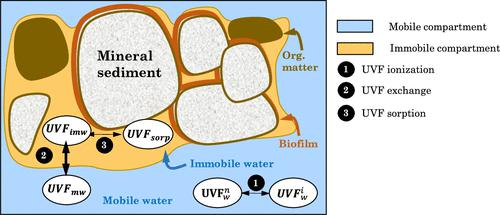当前位置:
X-MOL 学术
›
Environ. Sci. Technol.
›
论文详情
Our official English website, www.x-mol.net, welcomes your feedback! (Note: you will need to create a separate account there.)
Assessing the Fate of Benzophenone-Type UV Filters and Transformation Products during Soil Aquifer Treatment: The Biofilm Compartment as Bioaccumulator and Biodegrader in Porous Media
Environmental Science & Technology ( IF 11.4 ) Pub Date : 2024-03-11 , DOI: 10.1021/acs.est.3c08465 Sònia Jou-Claus 1, 2, 3 , Paula Rodríguez-Escales 1, 2 , Lurdes Martínez-Landa 1, 2 , M. Silvia Diaz-Cruz 3 , Jesús Carrera 2, 3 , Adrià Sunyer-Caldú 3, 4 , Gerard Quintana 3 , Cristina Valhondo 2, 3
Environmental Science & Technology ( IF 11.4 ) Pub Date : 2024-03-11 , DOI: 10.1021/acs.est.3c08465 Sònia Jou-Claus 1, 2, 3 , Paula Rodríguez-Escales 1, 2 , Lurdes Martínez-Landa 1, 2 , M. Silvia Diaz-Cruz 3 , Jesús Carrera 2, 3 , Adrià Sunyer-Caldú 3, 4 , Gerard Quintana 3 , Cristina Valhondo 2, 3
Affiliation

|
The fate of selected UV filters (UVFs) was investigated in two soil aquifer treatment (SAT) systems, one supplemented with a reactive barrier containing clay and vegetable compost and the other as a traditional SAT reference system. We monitored benzophenone-3 (BP-3) and its transformation products (TPs), including benzophenone-1 (BP-1), 4,4′-dihydroxybenzophenone (4DHB), 4-hydroxybenzophenone (4HB), and 2,2′-dihydroxy-4-methoxybenzophenone (DHMB), along with benzophenone-4 (BP-4) and avobenzone (AVO) in all involved compartments (water, aquifer sediments, and biofilm). The reactive barrier, which enhances biochemical activity and biofilm development, improved the removal of all detected UVFs in water samples. Among monitored UVFs, only 4HB, BP-4, and AVO were detected in sediment and biofilm samples. But the overall retained amounts were several orders of magnitude larger than those dissolved. These amounts were quantitatively reproduced with a specifically developed simple analytical model that consists of a mobile compartment and an immobile compartment. Retention and degradation are restricted to the immobile water compartment, where biofilm absorption was simulated with well-known compound-specific Kow values. The fact that the model reproduced observations, including metabolites detected in the biofilm but not in the (mobile) water samples, supports its validity. The results imply that accumulation ensures significant biodegradation even if the degradation rates are very low and suggest that our experimental findings for UVFs and TPs can be extended to other hydrophobic compounds. Biofilms act as accumulators and biodegraders of hydrophobic compounds.
中文翻译:

评估土壤含水层处理过程中二苯甲酮型紫外线过滤剂和转化产物的命运:生物膜室作为多孔介质中的生物蓄积剂和生物降解剂
在两个土壤含水层处理 (SAT) 系统中研究了选定的紫外线过滤器 (UVF) 的命运,其中一个系统补充了含有粘土和蔬菜堆肥的反应屏障,另一个作为传统的 SAT 参考系统。我们监测了二苯甲酮-3 (BP-3) 及其转化产物 (TP),包括二苯甲酮-1 (BP-1)、4,4'-二羟基二苯甲酮 (4DHB)、4-羟基二苯甲酮 (4HB) 和 2,2' -二羟基-4-甲氧基二苯甲酮 (DHMB),以及所有涉及的隔室(水、含水层沉积物和生物膜)中的二苯甲酮-4 (BP-4) 和阿伏苯宗 (AVO)。反应屏障可增强生化活性和生物膜形成,改善水样中所有检测到的 UVF 的去除。在监测的 UVF 中,沉积物和生物膜样品中仅检测到 4HB、BP-4 和 AVO。但总体保留量比溶解量大几个数量级。这些量通过专门开发的简单分析模型进行定量再现,该模型由移动隔室和固定隔室组成。保留和降解仅限于固定的水室,其中生物膜的吸收是用众所周知的特定化合物的K ow值来模拟的。该模型再现了观察结果,包括在生物膜中检测到的代谢物,但在(移动的)水样中未检测到代谢物,这一事实支持了其有效性。结果表明,即使降解率非常低,积累也能确保显着的生物降解,并表明我们对 UVF 和 TP 的实验结果可以扩展到其他疏水性化合物。生物膜充当疏水化合物的蓄积器和生物降解器。
更新日期:2024-03-11
中文翻译:

评估土壤含水层处理过程中二苯甲酮型紫外线过滤剂和转化产物的命运:生物膜室作为多孔介质中的生物蓄积剂和生物降解剂
在两个土壤含水层处理 (SAT) 系统中研究了选定的紫外线过滤器 (UVF) 的命运,其中一个系统补充了含有粘土和蔬菜堆肥的反应屏障,另一个作为传统的 SAT 参考系统。我们监测了二苯甲酮-3 (BP-3) 及其转化产物 (TP),包括二苯甲酮-1 (BP-1)、4,4'-二羟基二苯甲酮 (4DHB)、4-羟基二苯甲酮 (4HB) 和 2,2' -二羟基-4-甲氧基二苯甲酮 (DHMB),以及所有涉及的隔室(水、含水层沉积物和生物膜)中的二苯甲酮-4 (BP-4) 和阿伏苯宗 (AVO)。反应屏障可增强生化活性和生物膜形成,改善水样中所有检测到的 UVF 的去除。在监测的 UVF 中,沉积物和生物膜样品中仅检测到 4HB、BP-4 和 AVO。但总体保留量比溶解量大几个数量级。这些量通过专门开发的简单分析模型进行定量再现,该模型由移动隔室和固定隔室组成。保留和降解仅限于固定的水室,其中生物膜的吸收是用众所周知的特定化合物的K ow值来模拟的。该模型再现了观察结果,包括在生物膜中检测到的代谢物,但在(移动的)水样中未检测到代谢物,这一事实支持了其有效性。结果表明,即使降解率非常低,积累也能确保显着的生物降解,并表明我们对 UVF 和 TP 的实验结果可以扩展到其他疏水性化合物。生物膜充当疏水化合物的蓄积器和生物降解器。



























 京公网安备 11010802027423号
京公网安备 11010802027423号